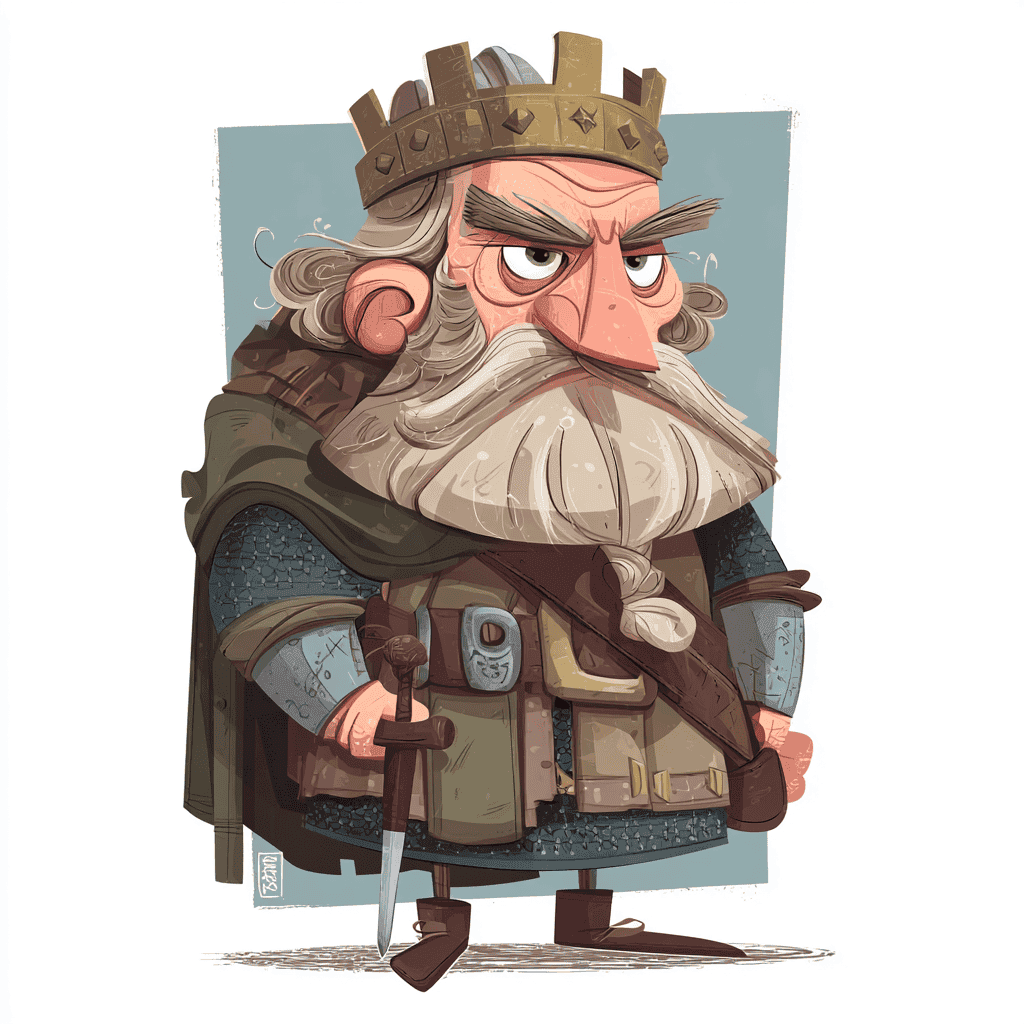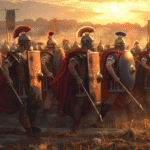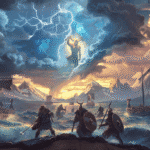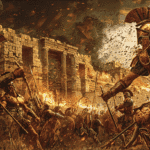Table of Contents
Ivar the Boneless and the Great Heathen Army: Comprehensive Study Guide for History Students
Ivar the Boneless stands as one of the few Viking figures whose historical existence is well-documented in contemporary sources—unlike his legendary father Ragnar Lothbrok. As the strategic mastermind behind the Great Heathen Army’s invasion of Anglo-Saxon England (865-878 CE), Ivar orchestrated campaigns that permanently altered English political geography, established the Danelaw, and forced the emergence of unified English resistance under Alfred the Great.
If you’re studying the Viking Age, Anglo-Saxon England, or medieval military history, understanding Ivar and the Great Heathen Army is essential. This invasion represents the transition from Viking raiding to conquest and settlement—a watershed moment that reshaped Britain’s ethnic, linguistic, and political landscape for centuries.
This comprehensive study guide examines Ivar the Boneless and the Great Heathen Army through multiple analytical lenses—biographical context, military strategy, political consequences, and historical legacy—providing the framework to critically engage with one of medieval history’s most consequential military campaigns.
Key Takeaways
- Ivar the Boneless is one of the best-documented Viking leaders, named in the Anglo-Saxon Chronicle, Irish Annals, and multiple independent 9th-century sources
- The Great Heathen Army (865-878 CE) represented the largest organized Viking invasion force in history, conquering three of four major Anglo-Saxon kingdoms
- Unlike earlier Viking raids focused on plunder, this campaign aimed at permanent territorial conquest and settlement, establishing the Danelaw
- Ivar’s nickname “the Boneless” (inn beinlausi) remains mysterious—theories include physical disability, flexibility, strategic cunning, or metaphorical meaning
- The invasion forced Anglo-Saxon political consolidation under Wessex leadership, inadvertently creating conditions for eventual English unification

Understanding Ivar and the Great Heathen Army: Historical Context
Before examining Ivar’s biography and campaigns, establishing what we can actually know from sources is crucial.
Source Quality and Historical Certainty
Contemporary sources (high reliability):
Anglo-Saxon Chronicle:
- Compiled late 9th century, drawing on earlier annals
- Names “Ivar” as Great Heathen Army leader
- Documents yearly campaigns (865-878)
- Written from Anglo-Saxon perspective (anti-Viking bias)
- Historical value: High for events, names, dates
Annals of Ulster (Irish):
- Contemporary Irish chronicle
- Records “Ímar” (Ivar) as Norse-Irish king
- Documents Dublin Viking kingdom activities
- Independent of English sources
- Historical value: High for corroboration
Annals of St-Bertin (Frankish):
- Contemporary continental chronicle
- Documents Viking activities in Francia
- Provides European context
- Independent perspective
- Historical value: Medium-high for context
Later sources (lower reliability):
Ragnarssona þáttr (Tale of Ragnar’s Sons):
- 13th-century Icelandic saga
- Connects Ivar to Ragnar Lothbrok
- Revenge narrative framework
- Legendary embellishments
- Historical value: Low for biography, medium for cultural understanding
Norse sagas (various):
- Written 300+ years after events
- Mix history and legend
- Cultural rather than historical documentation
- Provide Norse perspective missing from Anglo-Saxon sources
- Historical value: Low for facts, high for values/culture
What We Can Confidently Know
Historically certain:
- Viking army invaded England (865)
- Leader named Ivar/Ímar existed
- Army conquered Northumbria, East Anglia, Mercia
- Established long-term Viking control (Danelaw)
- Ivar ruled in Northumbria/Dublin
- Campaign lasted over decade
Historically probable:
- Multiple leaders (Ivar, Halfdan, others)
- Revenge partially motivated invasion
- Significant settlement followed conquest
- Changed Anglo-Saxon political landscape permanently
- Ivar died circa 873
Historically uncertain:
- Ivar’s exact relationship to “Ragnar Lothbrok”
- Meaning of “Boneless” nickname
- Precise biographical details
- Specific battle tactics and strategies
- Personal motivations and character
Historically unlikely/legendary:
- Snake pit death of Ragnar
- Blood eagle execution of King Aella
- Supernatural elements in sagas
- Precise dialogue and speeches
- Many saga narrative details
Ivar the Boneless: Life and Legacy
Ivar represents a rare Viking figure with solid historical documentation, yet mysteries persist.
Early Life and Origins
Birth and childhood:
Approximate dates:
- Born: ~820s-830s CE (estimated)
- Active: 860s-870s
- Death: ~873 CE (Irish Annals)
- Lifespan: Roughly 40-50 years
Family background (saga tradition):
- Father: Ragnar Lothbrok (legendary/uncertain historical figure)
- Mother: Aslaug (legendary prophetic queen)
- Brothers: Bjorn Ironside, Halfdan, Hvitserk, Sigurd, Ubbe
- Historical reality: Ragnar uncertain; brothers variably documented
The “Boneless” nickname mystery:
Theory 1: Physical disability
- Osteogenesis imperfecta (brittle bone disease)
- Caused by saga curse on Aslaug/Ragnar
- Would require carrying into battle
- Possible but would be remarkable military achievement
- Probability: Low-medium
Theory 2: Metaphorical/strategic
- “Boneless” meaning flexible, adaptable
- Strategic cunning and tactical fluidity
- Norse appreciation for clever epithets
- Fits documented military success
- Probability: Medium-high
Theory 3: Sexual meaning
- “Boneless” implying impotence
- No heirs/descendants recorded
- Saga references to condition
- Medieval euphemism possibility
- Probability: Medium
Theory 4: Berserker/trance warrior
- Religious/shamanic trance state
- “Boneless” as flexibility in battle frenzy
- Fits Norse warrior cult traditions
- Speculative but culturally grounded
- Probability: Low-medium
Theory 5: Mistranslation
- Error in saga transmission
- Original meaning lost
- Linguistic confusion
- Least satisfying but possible
- Probability: Low
Scholarly consensus: Unknown—likely metaphorical rather than literal physical description, but certainty impossible.
Upbringing and training:
Viking childhood (general context):
- Weapons training from age 6-7
- Ship navigation and seamanship
- Leadership and command
- Norse mythology and values
- Raiding participation by teens
Ivar specifically:
- Saga accounts unreliable for details
- Probably trained as warrior leader
- Developed strategic/tactical skills
- Possibly physical challenges requiring adaptation
- Rose to prominence by 860s
Family and Lineage
The Ragnar connection:
Saga narrative:
- Ivar son of legendary Ragnar Lothbrok
- Revenge for father’s death motivating invasion
- Brothers united by filial duty
- Family honor and vengeance central
Historical assessment:
- Ragnar Lothbrok: Probably legendary/composite figure
- No contemporary sources confirm Ragnar
- Possible historical figure(s) inspired legend
- Ivar’s fame may have created need for famous father
- Revenge narrative likely literary framework
The brothers:
Halfdan Ragnarsson:
- Historical certainty: High
- Anglo-Saxon Chronicle names him
- Co-leader of Great Heathen Army
- Ruled Northumbria after Ivar
- Died 877 (Chronicle records)
Ubbe:
- Historical certainty: Medium
- Chronicle mentions him
- Possibly killed Devon (878)
- Less prominent than Ivar/Halfdan
- Details uncertain
Bjorn Ironside:
- Historical certainty: Medium (for Mediterranean raid)
- Possibly same as Hastein’s partner
- Swedish connection claimed
- Less English involvement
- May be separate from Ivar’s family
Hvitserk/Sigurd:
- Historical certainty: Low
- Weak contemporary references
- Primarily saga figures
- May represent other historical Vikings
- Details unreliable
Family dynamics (saga vs. history):
Saga portrayal:
- Brothers cooperating in unified campaign
- Shared revenge motivation
- Conflicts over leadership and inheritance
- Eventual separation to different territories
Historical likelihood:
- Multiple Viking leaders definitely existed
- Some probably related
- Cooperation and rivalry both probable
- “Brothers” possibly symbolic (warband bonds)
- Family ties uncertain but possible
Leadership and Reputation
Rise to prominence:
Pre-invasion activities (860s):
- Raiding in England and Ireland
- Building reputation and following
- Establishing Dublin connections
- Forming alliances with other jarls
Great Heathen Army leadership (865-878):
- Primary strategic commander
- Political and military decisions
- Diplomatic negotiations
- Long-term planning and objectives
Leadership characteristics (from actions):
Strategic thinking:
- Long-term planning: Multi-year campaigns requiring logistics
- Adaptive strategy: Adjusting tactics to different kingdoms
- Political acumen: Negotiating treaties, installing puppet rulers
- Resource management: Maintaining army cohesion for 13+ years
Military skills:
- Siege warfare: Capturing fortified cities (York, others)
- Open battle: Defeating Anglo-Saxon armies repeatedly
- Naval operations: Coordinating ships and land forces
- Psychological warfare: Creating fear, exploiting divisions
Political leadership:
- Alliance building: Uniting multiple Viking groups
- Governance: Establishing control over conquered territories
- Diplomacy: Negotiating with Anglo-Saxon kingdoms
- Settlement planning: Facilitating Norse colonization
Reputation in sources:
Anglo-Saxon Chronicle:
- Names him as primary leader
- Records his victories
- Implies fear and respect (despite bias)
- Acknowledges strategic skill
Irish Annals:
- “Ímar, king of the Norsemen”
- Records Dublin rule
- Notes death (873): “Amlaíb Conung, son of the king of Lochlann, died”
- Suggests royal status and authority
Norse sagas:
- Cunning strategist (“boneless” as cleverness)
- Ruthless but effective leader
- Complex character (not just brutal)
- Remembered as great Viking
Legacy assessment:
Historical impact:
- Changed English political geography permanently
- Established Norse power in Britain and Ireland
- Forced Anglo-Saxon consolidation (unintended consequence)
- Created Danelaw with lasting cultural effects
Cultural memory:
- Remembered as great Viking leader
- Inspired later Viking expeditions
- Created model for conquest vs. raiding
- Symbol of Viking power at peak
The Great Heathen Army: Organization and Composition
The “Great Heathen Army” (Old English: mycel hæþen here) represented unprecedented Viking military organization.
Size and Composition
Army size estimates:
Anglo-Saxon Chronicle terminology:
- “Great Army” (mycel here)
- Implies larger than typical Viking raid forces
- Contrast with “Viking band” or “ship crews”
Modern estimates:
- Conservative: 1,000-2,000 warriors
- Middle estimate: 3,000-5,000 warriors
- High estimate: 10,000+ warriors (less likely)
- Scholarly consensus: Probably 2,000-5,000
Composition factors:
Multiple warbands unified:
- Various jarls and chieftains
- Different Scandinavian origins (Danish, Norwegian, Swedish)
- Unified command under Ivar and brothers
- Mutual interest in conquest/plunder
Support personnel:
- Warriors’ families (some campaigns)
- Slaves (thralls)
- Camp followers and merchants
- Craftsmen and specialists
- Total expedition: Perhaps 5,000-10,000+ people
Fleet size:
- Chronicle mentions “great fleet”
- Estimates: 200-500+ ships
- Mix of longships (military) and knarrs (transport)
- Required for mobility and supply
Military Organization
Command structure:
Supreme leadership:
- Ivar the Boneless (primary)
- Halfdan Ragnarsson (co-leader)
- Other jarls (subordinate commanders)
Organizational model:
- Warband (hirð) structure
- Personal loyalty to leaders
- Shared plunder distribution
- Democratic elements (assemblies for major decisions)
Tactical units:
- Ship crews (30-60 men)
- Fighting bands (100-200 men)
- Combined arms (foot, cavalry, naval)
- Flexible organization for different operations
Logistics and supply:
Foraging and plunder:
- Living off land (requisitioning/stealing food)
- Plunder financing continued operations
- Ransom and tribute (Danegeld)
- Established supply bases in conquered territories
Fortified camps:
- Winter camps (longphorts)
- Defensive earthworks
- Secure bases for operations
- Storage for plunder and supplies
Naval mobility:
- Rivers as highways (Thames, Trent, Ouse)
- Ships for rapid movement
- Strategic surprise through mobility
- Supply transport via water
Strategic Objectives
Initial goals (865):
Saga narrative:
- Revenge for Ragnar Lothbrok’s death
- Punishing King Aella of Northumbria
- Family honor and blood debt
Historical likelihood:
- Revenge possibly partial motivation
- More likely: Conquest and settlement
- Opportunity in Anglo-Saxon divisions
- Wealth and land acquisition
- Long-term Norse territorial expansion
Evolved objectives:
Territorial conquest:
- Permanent occupation, not just raids
- Installing Norse rulers
- Facilitating settlement
- Creating Norse kingdoms in Britain
Political control:
- Subduing Anglo-Saxon kingdoms
- Extracting tribute (Danegeld)
- Creating client kings
- Integrating territories into Norse world
Settlement facilitation:
- Opening land for Norse farmers
- Establishing trade networks
- Creating Norse-Gaelic culture
- Long-term colonization
The Great Heathen Army: Campaigns and Conquests
The invasion unfolded as a systematic conquest over 13+ years.
Invasion of Anglo-Saxon England (865-867)
Arrival and initial objectives:
Landfall (865):
- East Anglia chosen for landing
- Kingdom of Edmund
- Relatively weak militarily
- Good access to other kingdoms
East Anglian agreement:
- Edmund made peace/tribute deal
- Provided horses for Vikings
- Bought time for his kingdom
- Betrayed Anglo-Saxon unity
Move to Northumbria (866):
Northumbrian situation:
- Kingdom divided by civil war
- King Osberht vs. claimant Aelle
- Weakness inviting invasion
- York wealthy target
Capture of York (November 1, 866):
- Vikings seized city quickly
- Established as base (Jorvik)
- Strategic location controlling north
- River access for fleet
Northumbrian counterattack (867):
- Osberht and Aelle united against Vikings
- Attacked York (March 21, 867)
- Initially breached walls
- Vikings counterattacked and won decisively
Results:
- Both Northumbrian kings killed
- Kingdom effectively destroyed
- Vikings installed puppet king (Ecgberht)
- Northern England under Norse control
Conquest of Mercia and East Anglia (868-870)
Mercian campaign (868-869):
Initial invasion (868):
- Vikings left York for Mercia
- Occupied Nottingham
- Mercian King Burgred sought help
- West Saxon King Aethelred (Alfred’s brother) assisted
Standoff at Nottingham:
- Mercians and West Saxons besieged Vikings
- No major battle fought
- Vikings negotiated peace/tribute
- Returned to York (winter 868-869)
East Anglian conquest (869-870):
Return to East Anglia:
- Vikings marched south again
- King Edmund refused further tribute
- Prepared to resist
Defeat and death of Edmund:
- Battle at Hoxne (possibly)
- Edmund’s army defeated
- King captured and executed (November 20, 869)
- Later became St. Edmund (martyr)
Significance:
- East Anglia fully conquered
- Direct Norse rule established
- No puppet king—full annexation
- Base for further operations
The Wessex Wars (870-878)
Initial Wessex invasion (870-871):
Reading base (870):
- Vikings established camp at Reading
- Berkshire, on Thames River
- Threatened Wessex heartland
- King Aethelred and brother Alfred responded
Battle of Reading (January 871):
- West Saxons attacked Viking camp
- Repulsed with heavy losses
- Vikings held position
Battle of Ashdown (January 871):
- West Saxon counterattack
- Alfred led division
- Significant Viking casualties
- Viking retreat but not decisive defeat
Series of battles (871):
- Battle of Basing: Viking victory
- Battle of Meretun: Inconclusive
- Multiple engagements wearing both sides
- Aethelred died (April 871)
- Alfred became king
Peace treaty (871):
- Exhausted armies
- Money payment to Vikings
- Vikings left Wessex (temporarily)
- Moved to London (Mercia)
Conquest of Mercia (872-874):
Repton occupation (873-874):
- Vikings wintered at Repton
- Mercian King Burgred fled to Rome
- Puppet king Ceolwulf installed
- Mercia effectively conquered
Army division (874):
- Halfdan took portion north (Northumbria consolidation)
- Guthrum took remainder south (renewed Wessex campaign)
- Strategic split for different objectives
Final Wessex campaign (875-878):
Guthrum’s invasion (875-876):
- New Viking force under Guthrum
- Occupied Wareham (876)
- Moved to Exeter
- Alfred shadowed but avoided battle
Surprise attack (January 878):
- Vikings attacked Chippenham (Twelfth Night)
- Alfred’s court surprised
- King fled to Somerset marshes
- Guerrilla warfare from Athelney
Battle of Edington (May 878):
- Alfred gathered forces
- Met Guthrum’s army at Edington (Wiltshire)
- Decisive West Saxon victory
- Vikings retreated to Chippenham
Treaty of Wedmore (878):
- Guthrum accepted Christianity (baptized as Aethelstan)
- Vikings withdrew from Wessex
- Boundary established (River Lea)
- Creation of Danelaw—Viking-controlled territory
Major Battles: Detailed Analysis
Battle of York (867):
Context:
- Viking occupation since 866
- Northumbrian civil war resolved temporarily
- United attack to reclaim capital
Forces:
- Vikings: Unknown size, defending city
- Northumbrians: Combined armies of Osberht and Aelle
Outcome:
- Initial Northumbrian breach of walls
- Viking counterattack from multiple points
- Both Northumbrian kings killed
- Decisive Viking victory
Significance:
- Northumbria never recovered independence
- Established Norse York (Jorvik)
- Kingdom ceased to exist as Anglo-Saxon entity
Battle of Ashdown (871):
Context:
- Vikings campaigning in Wessex
- West Saxons needed victory
- Previous defeats at Reading
Forces:
- Vikings: Led by Ivar and/or Halfdan
- West Saxons: King Aethelred and Prince Alfred
Battle:
- Two-division engagement
- Alfred charged before Aethelred ready (legendarily impetuous)
- Fierce fighting around thorn tree
- Viking retreat
Outcome:
- West Saxon victory
- Significant Viking casualties mentioned
- Boosted West Saxon morale
- Not decisive—Vikings remained powerful
Significance:
- Showed Vikings could be defeated
- Established Alfred as military leader
- Prevented complete conquest of Wessex (delayed)
Battle of Edington (878):
Context:
- Alfred’s guerrilla campaign from Athelney
- Guthrum’s Vikings controlled much of Wessex
- Decisive confrontation needed
Forces:
- Vikings: Guthrum’s army (reduced after years of war)
- West Saxons: Alfred’s assembled forces from Somerset, Wiltshire, Hampshire
Battle:
- Location: Edington, Wiltshire
- Open field engagement
- Hard fighting all day
- West Saxon shield wall held
Outcome:
- Viking defeat and flight
- Two-week siege at Chippenham
- Viking surrender
Significance:
- Saved Wessex from conquest
- Forced treaty creating Danelaw
- Established Alfred’s reputation
- Watershed moment in English history
Key Figures and Alliances
Viking leadership:
Ivar the Boneless (until ~873):
- Supreme commander
- Strategic planner
- Political negotiator
- Ruled Northumbria/Dublin
Halfdan Ragnarsson:
- Co-leader with Ivar
- Took northern command (874)
- Ruled Northumbria (after Ivar)
- Died 877 in Ireland
Guthrum (Aethelstan after baptism):
- Emerged as leader mid-870s
- Led final Wessex campaign
- Became East Anglian king after Treaty of Wedmore
- Died 890
Anglo-Saxon resistance:
King Aethelred of Wessex:
- Led initial resistance (870-871)
- Multiple battles against Vikings
- Died April 871
- Succeeded by brother Alfred
King Alfred the Great:
- Most successful Viking opponent
- Innovative military reforms
- Only English king called “the Great”
- Saved Wessex, foundation for unified England
Kings Edmund (East Anglia), Burgred (Mercia):
- Unable to resist effectively
- Kingdoms conquered
- Edmund martyred
- Burgred fled into exile
Viking alliances:
Internal cooperation:
- Multiple jarls unified under Ivar/Halfdan
- Shared plunder and glory
- Common Norse identity
- Occasional tensions but sustained unity
Local collaboration:
- Puppet kings installed (Ceolwulf of Mercia, Ecgberht of Northumbria)
- Some Anglo-Saxons collaborated
- Norse-English alliances in Danelaw
- Economic integration over time
Tactics and Military Strategies
Strategic approaches:
Mobility and surprise:
- Ships for rapid movement
- River navigation reaching inland
- Unexpected routes and timing
- Strategic surprise (Chippenham attack)
Fortified bases:
- Winter camps with earthworks
- Secure positions for operations
- Supply storage and army rest
- Difficult for enemies to dislodge
Divide and conquer:
- Exploiting Anglo-Saxon disunity
- Separate peace treaties isolating kingdoms
- Preventing coordinated resistance
- Puppet rulers creating divisions
Siege warfare:
- Capturing fortified towns (York, others)
- Patience in sieges
- Storming when opportunity arose
- Combining blockade and assault
Tactical methods:
Shield wall (skjaldborg):
- Dense formation of overlapping shields
- Spears thrust between shields
- Primary infantry tactic
- Required discipline and courage
Berserkers and champions:
- Elite warriors leading attacks
- Psychological intimidation
- Breaking enemy formations
- Inspiring own troops
Feigned retreat:
- Drawing enemies from strong positions
- Ambushing pursuing forces
- Classical Viking tactic
- Requires discipline to execute
Combined arms:
- Infantry, cavalry (after acquiring horses), naval
- Coordinated operations
- Adapting to circumstances
- Tactical flexibility
Psychological warfare:
Reputation and fear:
- Viking fearsome reputation preceding them
- Stories of brutality (true and exaggerated)
- Demoralizing enemies before battle
- Propaganda value of victories
Divide enemy will:
- Offering favorable terms to some
- Threat of total destruction to others
- Creating uncertainty and mistrust
- Weakening resistance psychologically
Impact and Historical Significance
The Great Heathen Army’s invasion fundamentally transformed Britain.
Transformation of Anglo-Saxon Kingdoms
Political reorganization:
Before invasion (pre-865):
- Seven kingdoms (Heptarchy): Northumbria, Mercia, East Anglia, Essex, Sussex, Wessex, Kent
- Mercia dominant in 8th century
- Wessex rising in early 9th century
- Multiple independent kingdoms competing
After invasion (post-878):
- Three kingdoms conquered: Northumbria, East Anglia, Mercia (eastern)
- Wessex surviving and strengthened
- Danelaw established (Viking-controlled territory)
- Path to English unification begun
The Danelaw:
Geographic extent:
- Northern England (Northumbria)
- Eastern England (East Anglia)
- Eastern Mercia
- Five Boroughs: Derby, Leicester, Lincoln, Nottingham, Stamford
- Treaty of Wedmore boundary (878)
Characteristics:
- Danish law and customs
- Norse settlement and colonization
- Bilingual population (Old Norse and Old English)
- Different legal traditions
- Semi-autonomous under Norse jarls/kings
Cultural impact:
- Place names: -by (town), -thorpe (village), -thwaite (clearing)
- English language influence: Over 1,000 Old Norse words
- Legal concepts (bylaw, outlaw, etc.)
- Social structures mixing Norse and Anglo-Saxon
- Genetic legacy (Scandinavian DNA markers)
Long-term political effects:
Wessex dominance:
- Only surviving independent Anglo-Saxon kingdom
- Alfred the Great’s reforms strengthening it
- Ideological leadership of Anglo-Saxon resistance
- Foundation for eventual kingdom of England
English unification:
- Alfred’s successors (Edward the Elder, Athelstan)
- Reconquest of Danelaw (10th century)
- Creation of unified English kingdom by 954
- Ironically, Viking invasion catalyzed unification
Institutional changes:
Military reforms:
- Alfred’s burh (fortified town) system
- Standing army (select fyrd)
- Naval development
- Improved fortifications
Administrative innovations:
- Shires and hundreds organization
- Legal codification
- Taxation systems
- Central bureaucracy
Legacy in British and European History
Broader European context:
Viking Age peak:
- Great Heathen Army part of broader Viking expansion
- Contemporary with Norse settlements: Iceland, Ireland, Normandy
- Peak of Viking power (9th-10th centuries)
- Influencing all of Europe
Continental comparisons:
- Viking Paris siege (885-886)
- Seine River settlements
- Normandy creation (911)
- Parallel Norse expansion patterns
British Isles transformation:
Ireland:
- Ivar’s Dublin kingdom
- Norse-Gaelic culture
- Viking Irish trade networks
- Political fragmentation reinforced
Scotland:
- Norse Hebrides and Northern Isles
- Impact on Scottish kingdom formation
- Cultural exchanges
- Maritime connections
Wales:
- Indirect effects (pressure from east)
- Viking raids on coast
- Political impacts from English changes
- Cultural resilience
Long-term consequences:
English identity:
- Forged through Viking resistance
- Alfred as national hero
- Common enemy creating unity
- Foundation myths of English nation
Language:
- Old Norse contributions to English
- Placenames preserving history
- Legal terminology
- Everyday words (sky, egg, window, etc.)
Genetics:
- Scandinavian genetic markers in England
- Highest in former Danelaw regions
- Permanent population legacy
- British genetic diversity increased
Political geography:
- Regional identities (North vs. South)
- Administrative divisions reflecting Viking era
- Legal traditions varying by region
- Historical memory in regions
Cultural Memory and Depictions
Medieval sources:
Anglo-Saxon Chronicle:
- Primary historical source
- Anti-Viking bias but documented facts
- Created during Alfred’s reign
- Continued for centuries
Sagas:
- Norse perspective (centuries later)
- Legendary embellishment
- Cultural values expressed
- Entertainment and memory
Later medieval writings:
- Chronicles expanding stories
- Hagiographies (St. Edmund)
- Political uses of Viking memory
- Connecting contemporary to past
Modern depictions:
History Channel’s “Vikings” (2013-2020):
Ivar’s portrayal (Alex Høgh Andersen):
- Major character seasons 4-6
- Physical disability depicted (brittle bones, leg braces)
- Strategic genius emphasized
- Complex, ruthless personality
- Relationships with brothers central
Historical accuracy:
- General historical framework
- Many invented/altered details
- Compressed timelines
- Modernized sensibilities
- Entertainment over documentation
Cultural impact:
- Massive global audience
- Renewed Viking interest
- Tourism to Viking sites
- Academic opportunities and challenges
Other media:
Video games:
- Assassin’s Creed Valhalla (Great Heathen Army context)
- Total War series
- Crusader Kings
Literature:
- Historical fiction novels
- Young adult books
- Academic studies
- Popular histories
Academic scholarship:
- Ongoing research
- Archaeological discoveries
- DNA studies
- Interdisciplinary approaches
Historical memory debates:
Heroic vs. brutal:
- Vikings as adventurous explorers
- Vikings as violent raiders
- Balanced understanding needed
- Multiple perspectives valid
National identity uses:
- English heritage (Alfred’s resistance)
- Scandinavian pride (Viking achievement)
- Irish history (Norse-Gaelic)
- Political appropriations (problematic)
Modern relevance:
- Migration and settlement debates
- Cultural integration questions
- Identity and belonging
- Historical analogies (careful use needed)
Critical Analysis: Evaluating Historical Significance
Synthesizing scholarship and evidence:
What Made the Great Heathen Army Different?
Contrast with earlier Viking activity:
Typical Viking raids (793-865):
- Small bands (single ship to few ships)
- Hit-and-run tactics
- Coastal/monastery targets
- Plunder and return home
- Seasonal (summer) campaigns
Great Heathen Army innovation:
- Massive unified force
- Multi-year campaigns
- Territorial conquest objectives
- Settlement and colonization
- Political control establishment
- Year-round operations
Why this transition occurred:
Push factors (Scandinavia):
- Population pressure
- Limited agricultural land
- Political consolidation reducing opportunities
- Inheritance systems (younger sons landless)
- Warrior culture seeking glory/wealth
Pull factors (England):
- Anglo-Saxon weakness and disunity
- Wealthy, developed kingdoms
- Success of earlier raids
- Settlement land available
- Economic opportunities
Strategic innovation:
- Organized leadership (Ivar’s strategic genius)
- Sustained logistics and supply
- Political sophistication
- Long-term planning
- Adapting raiding tactics to conquest
Counterfactual: What If?
If Great Heathen Army failed:
- Anglo-Saxon kingdoms remaining divided
- No catalyst for English unification
- Different linguistic evolution
- Alternative British political geography
- No Danelaw cultural legacy
If Vikings conquered all England:
- Fully Norse British Isles
- Different European balance
- Alternative English identity/language
- Changed European medieval history
- Different modern Britain
Historical significance:
- Real history: Compromise creating hybrid culture
- Viking invasion not complete
- English survival creating tension and synthesis
- Danelaw as middle ground
- Foundation for later developments
Scholarly Debates
Ivar’s role:
- How much credit personally?
- Individual vs. collective leadership?
- Strategic genius or fortunate circumstances?
- Sources’ reliability about individuals?
Army size and composition:
- How large actually?
- Single unified force or coalition?
- Logistics and sustainability questions
- Scaling contemporary estimates
Settlement patterns:
- How many Norse settled?
- Peaceful vs. violent displacement?
- Integration with Anglo-Saxons?
- Genetic evidence interpretation
Long-term impact:
- Positive vs. negative assessment?
- Inevitable vs. contingent unification?
- Cultural synthesis benefits?
- Violence and destruction costs?
Conclusion: The Enduring Legacy of Ivar and the Great Heathen Army
Ivar the Boneless and the Great Heathen Army represent a pivotal moment when Viking activity transformed from raiding to state-building, when Anglo-Saxon England faced its greatest existential crisis, and when the foundations of eventual English unity were paradoxically laid through foreign invasion.
Historical certainty:
- Ivar existed and led major invasion
- Great Heathen Army conquered three kingdoms
- Created Danelaw with lasting consequences
- Forced Anglo-Saxon adaptation and evolution
- Changed British history permanently
Key insights:
Military significance: Demonstrated sophisticated Viking military organization, strategic planning, and political acumen far beyond stereotypical “raiders”
Political impact: Inadvertently created conditions for English unification by destroying all kingdoms except Wessex, forcing consolidation under Alfred’s leadership
Cultural legacy: Created lasting hybrid Norse-English culture in Danelaw, contributing significantly to English language, law, place names, and identity
Methodological lesson: Shows importance of critical source analysis—contemporary sources reliable for events, later sagas unreliable for biographical details, archaeology providing crucial context
For students: Ivar and the Great Heathen Army offer a compelling case study in medieval military history, state formation, cultural contact, and the relationship between individual leadership and historical forces. The invasion’s consequences—political, cultural, linguistic, genetic—remain visible in Britain today, making this not merely “medieval history” but the foundation of modern England.
The ultimate irony: The Great Heathen Army’s partial success—conquering most but not all of Anglo-Saxon England—created the conditions for eventual English unification under Wessex, the very survival of which was the invasion’s greatest failure. Ivar’s strategic brilliance brought Vikings to their peak power in Britain, while simultaneously sowing seeds of their eventual political absorption into an English identity they had forced into existence.
Whether viewed as brutal conquerors or skilled state-builders, Ivar the Boneless and the Great Heathen Army fundamentally shaped medieval and modern Britain in ways that remain visible and significant over a millennium later.




